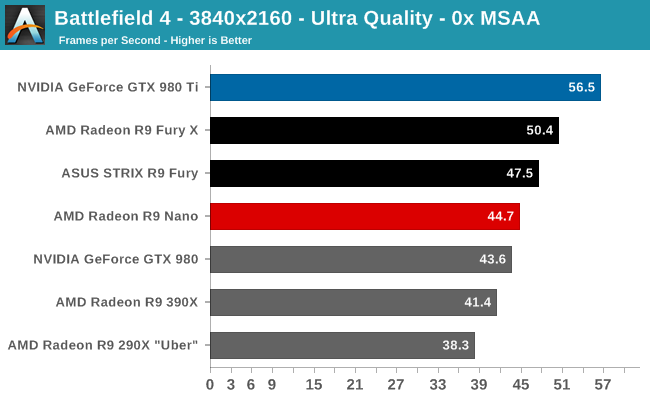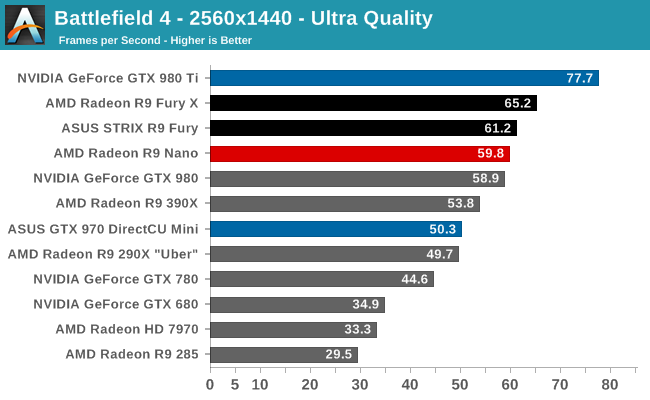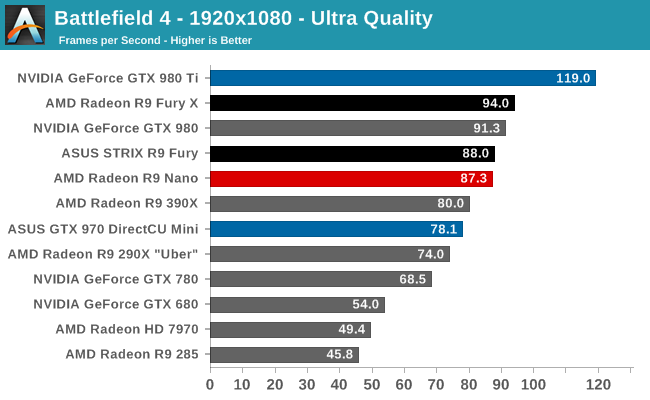The AMD Radeon R9 Nano Review: The Power of Size
by Ryan Smith on September 10, 2015 8:00 AM ESTBattlefield 4
Kicking off our benchmark suite is Battlefield 4, DICE’s 2013 multiplayer military shooter. After a rocky start, Battlefield 4 has since become a challenging game in its own right and a showcase title for low-level graphics APIs. As these benchmarks are from single player mode, based on our experiences our rule of thumb here is that multiplayer framerates will dip to half our single player framerates, which means a card needs to be able to average at least 60fps if it’s to be able to hold up in multiplayer.




Like the other Fiji cards, AMD is promoting the R9 Nano in part on its 4K capabilities. And while we disagree that this card is suitable for 4K gaming based on its sub-Fury performance, we’re including 4K results anyhow to serve as a point of comparison.
In any case Battlefield 4 is often a good indicator of general card performance, and for the R9 Nano this is no exception. What we find is that the R9 Nano trails the other Fury cards in all cases. However to our initial surprise, the R9 Nano sticks rather close to the R9 Fury. The petite powerhouse trails the R9 Fury by only 1-6%, which for the record is a smaller gap than we were expecting.
While the R9 Nano packs a full Fiji GPU, AMD has to pull back on clockspeeds to hit their power targets; in the case of Battlefield 4 this is an average clockspeed of just 879MHz at 2560x1440. Given this we had been expecting the R9 Nano to deliver around 85-90% of the performance of the R9 Fury (and about 80% of the R9 Fury X), based on the assumption that average clockspeeds would be closer to 800MHz. So the fact that the R9 Nano starts off as close to the R9 Fury as it does – even if it’s still trailing it – is a pleasant surprise.
Otherwise with performance still clearly occupying a position as a “3rd tier” Fiji card, I’m not sure if anything about these results should be surprising. On a price/performance basis AMD is not intending to be competitive with other $650 cards, so the R9 Fury X and GTX 980 Ti are of course on the top of the heap. What you get instead is a card that delivers around 90% of R9 Fury X’s performance in BF4 with much less power consumption.
Moving on, compared to the lower power and smaller cards, the R9 Nano is as expected a clean sweep. Demonstrating the virtues of a wide and lower clocked processor’s ability to deliver strong performance without requiring extreme power, everything from the R9 285 to the GTX 980 trails the R9 Nano here. Compared to the GTX 970 Mini in particular, the R9 Nano is 12-26% faster depending on the resolution.
The one potential problem here for the R9 Nano is the GTX 980. Though not a Mini-ITX card, the GTX 980’s power consumption is going to be fairly close to the R9 Nano’s, definitely more so than GTX 970’s. From a power efficiency standpoint it’s the GTX 980 that poses the greatest challenge to the R9 Nano, and while it’s ahead of the GTX 980 in this case at 2560x1440 and higher, it’s a sign that AMD should be worried about what could happen if an NVIDIA partner produced a Mini-ITX GTX 980.










284 Comments
View All Comments
Qwertilot - Thursday, September 10, 2015 - link
Also Intel's 35w quad cores seem to be getting rather fast nowadays, so overall system power/a very quiet CPU cooler is much easier to handle. Not many really tiny cases mind.Also maybe a question of if you want to go one fan for something with this much power draw - it can be tamed to very, very quiet by 2 fan designs.
mosu - Thursday, September 10, 2015 - link
I wonder how Nvidia will manage HBM2 with no previous experience with HBM. Maybe TSMC will borrow some for them...nathanddrews - Friday, September 11, 2015 - link
Probably just fine seeing as they have been designing Pascal for a few years and they just began sampling a few months ago, meaning they likely have working chips in their labs right now. AMD managed fine with their first implementation. Intel seems to be doing well with their version of stacked memory. Samsung and Toshiba are also doing fine. No one would be bringing it to the consumer market if they didn't already have a good handle on it.Michael Bay - Thursday, September 10, 2015 - link
I will be an asshole and remind everybody that there is _still_ no 960 review.MrSpadge - Thursday, September 10, 2015 - link
What exactly would you expect from an AT review now that can not already be found elsewhere? I know they said a review would be coming, but seriously.. let them focus on important topics.bill.rookard - Thursday, September 10, 2015 - link
You are absolutely right. On both points.Mikemk - Thursday, September 10, 2015 - link
Really?extide - Thursday, September 10, 2015 - link
They SAID that there will not be a 960 review.Oxford Guy - Thursday, September 10, 2015 - link
Because the 960 was a poor product that made Nvidia look bad?D. Lister - Wednesday, September 16, 2015 - link
No, because AT was understaffed and they kept delaying it, until they realised that they were so late (compared to other sites) that the meager hits their review would get, wouldn't be worth the effort that they would have to put in.As for your inability to find a review, allow me to assist:
https://www.google.com/search?q=960+review&rlz...